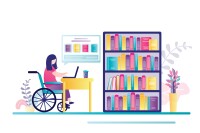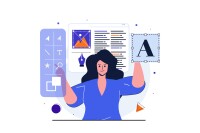Search
There are 29 results.
Category
Tag
Tag
All (29)
Alt Text (1)
Belonging (3)
Color Contrast (1)
Communication (2)
Community (2)
Content Creation (12)
Course Materials (9)
Course Preparation (3)
Diversity (3)
Equity (2)
Faculty Support (1)
Formative Assessments (1)
Images (1)
Inclusion (8)
Page Design (1)
PowerPoint (1)
Representation (2)
Rubrics (1)
Screen Readers (1)
Universal Design for Learning (UDL) (3)
Video (1)
Visual Accessibility (2)
Five Ways to Combat Linguistic Bias in the Classroom
Developments such as the evolution of World Englishes (WE) and African American scholars’ use of African American Vernacular English (AAVE) have opened an important dialogue around academic writing standards, language ownership, and linguistic justice (Canagarajah, 2006; Young, 2010). Authors like Gloria Anzaldua who mix, for example, Native Indian, Spanish, and English in texts, are engaging in the literary tradition of code meshing, which has been shown to facilitate acquisition of English when used by multicultural students in the classroom, according to research (Canagarajah, 2006). By adopting inclusive practices, course designers can combat linguistic bias and promote writing achievement for all learners. This piece contains five recommendations for reducing linguistic bias in online education.
Don't Leave Your Learners Behind: Start Tackling Web Accessibility Now!
If you’re an educator, you're probably familiar with the concept of accessibility, which often manifests in the classroom in the form of accommodation requests to meet specific students' needs. If you're an online educator, you've hopefully heard about web accessibility, which requires adhering to specific guidelines when designing and providing materials via the web, reducing the need for student accommodations by anticipating and removing potential barriers to learning.
Audio-Only Content to Support Learning
In comparison to instructional videos, the role of audio-only instructional content in online learning has received scant attention. When audio-only content is discussed, the research often centers on the use of audio feedback or student-created podcasts, rather than instructor-created instructional audio. Additionally, few studies have compared learning outcomes from recorded video lectures versus from audio alone, except within the context of specific disciplines, such as second language acquisition (Berner & Adams, 2004).
Hyperlink Dos and Don'ts
When designing a course, you want to ensure that all students can access the websites and documents that you link to. Accessible hyperlinks are particularly important for students with screen readers, which read the links out loud. This piece contains best practices for writing and formatting accessible hyperlinks so that all learners can access the content that you have curated for your course.
Accessibility Considerations for Students With Motor Disabilities
Online courses can offer numerous advantages to students. In order for all students to benefit from these advantages, it is essential to prioritize accessibility needs in all aspects of course design and delivery. This piece focuses on considerations and recommendations for enhancing the accessibility of online courses for students with motor impairments.
Inclusive Texts
Today’s student population is diverse and includes marginalized groups that have historically been excluded from mainstream education (Ladson-Billings, 2013). In 2021, students of color comprised upwards of 40% of the 15.4 million undergraduates enrolled in U.S. colleges and universities (Nam, 2024; National Center for Education Statistics, 2023). Ladson-Billings (2013), whose work centers on culturally relevant pedagogy, argues that diverse students require inclusive learning to succeed. “[These students] do not fit neatly into the rigid categories of race, class, gender, or national origin” upon which hierarchies of the past have been built (p. 5), so authentic representation of diversity in higher education is critical. Adrienne Keene, an assistant professor of American Studies at Brown University, writes that instructors can do their part to support underrepresented students by being honest about their own bias and blind spots, critiquing their course materials, and integrating meaningful representations of diversity into the curriculum (Keene, 2015).
No Sweat Alt Text
What is “alt text”? Alt text is descriptive text linked to an image, graph, or other visual content that allows users to understand the visual without viewing it. Any image online should contain alt text, but guidelines differ depending on whether the image is simply decorative or related to other content on the page.









